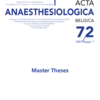Update on best current practice of non-pharmacological interventions reducing preoperative anxiety in children, a semi-systematic literature review
preoperative anxiety; children; general anesthesia
Published online: Apr 21 2022
Abstract
Background: Preoperative anxiety in children typically associates with emergence delirium, postoperative pain, analgesic need and new-onset maladaptive behavioral changes. Non-pharmacological interventions are able to reduce anxiety without need to expose children to drug therapy and it’s possible side effects. The goal of our semi-systematic review is to provide an update on current best practice to reduce preoperative anxiety in children and improve cooperation during induction of general anesthesia with non-pharmacological interventions.
Methods: The Medline database was searched using Mesh terms ‘ anesthesia’, anxiety’ and ‘children’ for articles with publication date until November 2020. A total of 646 articles were identified and screened for inclusion based on their titles and abstracts by 2 independent reviewers. A total of 27 articles were included, 26 randomized controlled trials and 1 meta-analysis. Grading of evidence was conducted using a modified Bizzini score.
Results: Both distraction with cartoons and transporting the children in a toy car proved effective therapy. Same day mask exposure or creating a low sensory stimuli environment reduced anxiety. Parental presence during induction of general anesthesia showed no effect on reduction of anxiety level.
Conclusions: Distraction, same day mask exposure and low sensory stimuli are good interventions to reduce preoperative anxiety in children. Future research should include a larger study population and focus on children with comorbidities and behavioral problems which are known to increase their baseline anxiety.
